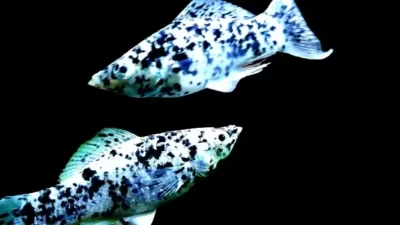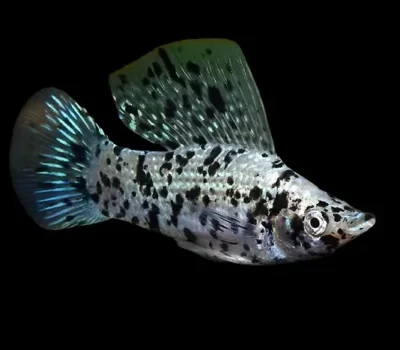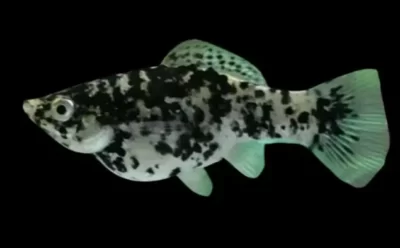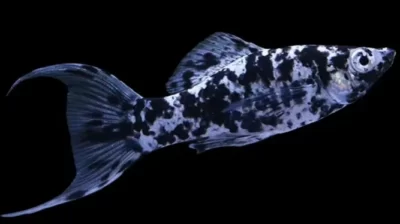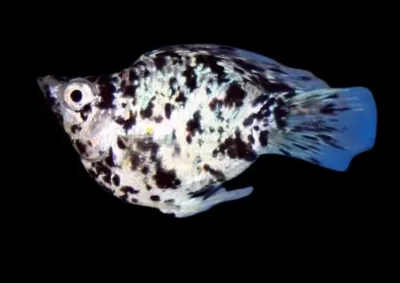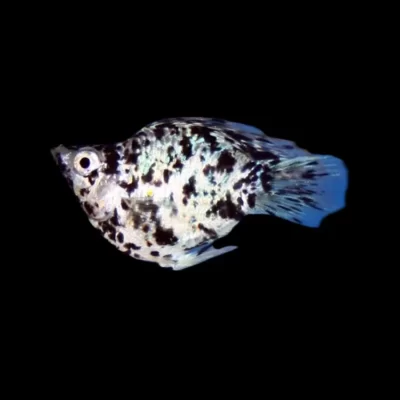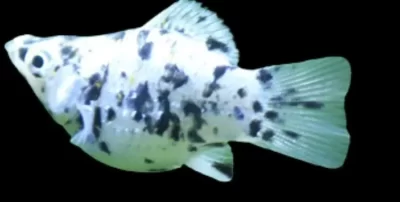The Dalmatian Molly is a hybrid color variation of Poecilia latipinna, the Sailfin Molly. Dalmatian Mollies have a spotted pattern on their bodies, which is similar to the spots found on Dalmatian dogs hence its name Dalmatian Molly. These spots are black. Dalmatian Mollies are livebearers and hence instead of laying eggs, the female gives birth to live fries. The most defining characteristic of Dalmatian Mollies is their spotted pattern. The spots can vary in size and density, and they typically contrast against the base color of the fish.
Mollies, in general, are known for their hardiness which makes them suitable for aquarium hobbyists of various experience levels. They adapt to a range of water conditions, but they need a well-maintained and stable environment. Regular 30% water changes once in 15 days and cleaning of the tank are necessary to maintain a healthy environment. Feeding them a balanced and varied diet is also essential for their well-being.
1) Different types of Dalmatian molly fishes
2) Are Dalmation Mollies Aggressive?
3) Dalmatian molly Tank size and water parameters
5) Best Food for Dalmatian Mollies
6) Pregnant Female Dalmatian Molly
7) Dalmatian molly fish Breeding.
8) Dalmatian molly fish diseases.
Different types of Dalmatian mollyfishes
Dalmatian Mollies come in different color variations and patterns, and the specific types are based on the Fin type based on selective breeding efforts by fish breeders.
Here are some common types of Dalmatian Mollies based on Fin pattern and colorations:
Sailfin Dalmatian Molly:
The most common Dalmatian or Marble Mollies, with males having a large, sail-like dorsal fin. They are slightly aggressive, especially when kept with other male sailfin Dalmatian mollies. So, it would help if you watched out when keeping many males together.
The Female Dalmation Molly:
The female Dalmatian or Marble Mollies have a smaller dorsal fin and are more rounded. The female Dalmatian Mollies have a gravid dark spot near the anal fin. The spot becomes more prominent as the female approaches pregnancy.
Lyretail Dalmatian Molly:
This lyretail Dalmatian molly has a longer flowing tail and fins with pointed tips, resembling a lyre. The Lyretail Dalmatian Mollies can come in various colors like black, white, silver, gold, or other mixed colors.
Balloon Dalmatian Molly:
Balloon Dalmation Mollies have a rounded or ballooned body shape. These mollies are a result of selective breeding. The body of a Balloon Dalmatian Molly is more rounded than that of the standard Molly.
Balloon Dalmatian Molly Female:
Female Balloon Dalmatian Mollies share many different characteristics with their male counterparts. They are more rounded. Females may exhibit less aggression compared to males. Their fins are not as pronounced as the male ones and you might notice a dark spot near her anal fin.
Are Dalmation Mollies Aggressive?
Dalmatian Mollies, like other Molly varieties, are generally considered a bit peaceful. However, the behavior of individual fish can vary, and some factors may influence their level of aggression. Here are some factors to be taken into consideration:
Gender Ratio
Maintaining a proper gender ratio is crucial in a Molly tank. Male Mollies can sometimes exhibit more aggressive behavior, especially if there are too many males compared to females. A recommended ratio is to have more females than males to divert their attention toward the female one.
Dalmatian molly Tank size and water parameters:
Dalmatian Mollies need a 20-gallon tank at the minimum. If you are adding more fish then you would need a 30 to 40-gallon tank. Crowding too many mollies in a small place would stress them. The needs a water pH of around 7 to 8 and a hardness of around 12–24 dGH. They live best at a temperature of around 70–82°F.
Dalmantian Tank Mates
Suitable fish tank mates for Dalmatian mollies:
- Shubunkins
- Rosy barbs
- Rasboras
- Dwarf gouramis
- Guppies
- Platies
Best Food for Dalmatian Mollies
Dalmatian mollies are omnivorous and hence they eat both plant and animal matter. These fishes also eat small insects, worms, and algae. Provide them with a variety of foods like frozen bloodworms, brine shrimp, and freeze-dried pellets.
Dalmatians should only be fed twice or thrice per day. Don’t overfeed them as it can lead to health problems like bloating and constipation.
Pregnant Female Dalmatian Molly
Determining whether a female Dalmatian Molly is pregnant involves observing certain physical and behavioral changes. Here are some signs that can indicate pregnancy in a female Dalmatian Molly:
One of the most reliable indicators is the presence of a pronounced dark spot near the anal fin and a bigger belly than usual.
They display an increased appetite. They might eat more as they need additional energy for carrying and eventually giving birth to the fry.
The males, might show increased interest in the pregnant female. This is a natural behavior as males attempt to mate with the female.
Dalmatian molly fish Breeding:
Breeding Dalmatian Mollies would be interesting for hobbyists. Some of the steps for breeding Dalmatian Mollies are below:
Set up a Breeding Tank:
Set up a separate breeding tank to provide a clean environment in the tank. The tank should be sized appropriately with clean water conditions. Adding live plants and decorations to the tank would provide hiding spots for the fry which encourages the Females to breed.
Create Ideal Water Conditions:
Maintain optimal water parameters for breeding. Temperatures should be between 75-82°F, slightly alkaline to neutral pH (7.0-7.8), and a moderate hardness.
Gender Ratio:
Ensure that the tank has a proper gender ratio with more females than males to reduce the aggressive behavior of males. Having too many males can sometimes harass females during the breeding process.
Condition the fish:
Feed high-quality and variety of foods. Fish food should be rich in protein and spirulina. Try live or frozen foods with a combination of spirulina to keep them happy and enhance their reproductive health.
Allow the fish to give Natural Birth:
Dalmatian Mollies give birth to live fry without much assistance. Allow the females to go through the breeding process naturally. Once they breed the fry would swim freely once they are born. After the birth of the fries remove the parents from the breeding tank so that they don’t end up eating the fry.
Provide Proper Fry Care:
After birth move the fry to a separate fry tank or remove the parents. Feed the fry with finely crushed food until they are large enough to consume normal food. Having the fry for a period of 20 to 25 days in a separate tank would be good enough for them to grow a bit bigger. You can leave the fries after 20 to 25 days in the main tank.
Dalmatian Molly Diseases
Like any aquarium fish, Dalmatian Mollies are susceptible to various diseases. Maintaining good water quality, and providing a balanced diet is the key to preventing diseases. Sometimes diseases can come through the bacteria or fungi that are present in live plants. Make sure to quarantine the plants in a medicated environment for a few hours.
Below are some of the most common diseases that affect Dalmatian Mollies:
Ich:
Ich is a common protozoan parasite that causes white cysts or spots on the fish’s skin, fins, and gills. It often occurs due to poor water conditions and an unhealthy diet. Increasing the temperature slightly, and adding a few pinches of aquarium salt can ward away bacteria and fungi during the initial stages. Adding liquid medicine can help treat the ich during the initial stages.
Bacterial infection:
Columnaris is a common bacterial infection that can cause white patches on the skin, fins, or gills. It makes the fish lethargic and fish could find difficulty in breathing. The fish would often stay isolated when it is affected by disease. Antibacterial medications can be used to treat them. Add antibacterial medication and do a 30 percent water change after 1 or 2 days. Repeat the process one more time. If the disease does not disappear then I would recommend a complete water change.
Fungal Infections:
Fungal infections look like a cotton-like growth on the skin, fins, or gills. Poor water conditions lead to fungal infections. Treat them with Antifungal medications at the earliest.
Velvet Disease:
Velvet disease is caused by the protozoan parasite called Oodinium. The Infected molly fish might display a rusty dust-like appearance on the skin. Copper-based medications are the best and are commonly used to treat velvet disease.
Fin Rot:
Fin rot is a bacterial infection that causes the deterioration of fins. It often occurs due to poor water quality due to ammonia build-up and poor food quality. Antibiotics and improved water conditions can help treat fin rot.
Preventive measures and early detection are crucial in maintaining the health of Dalmatian Mollies. Quarantine the sick fish so that the diseases do not spread to the other ones.

